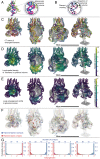Active entanglement enables stochastic, topological grasping
- PMID: 36215466
- PMCID: PMC9586297
- DOI: 10.1073/pnas.2209819119
Active entanglement enables stochastic, topological grasping
Abstract
Grasping, in both biological and engineered mechanisms, can be highly sensitive to the gripper and object morphology, as well as perception and motion planning. Here, we circumvent the need for feedback or precise planning by using an array of fluidically actuated slender hollow elastomeric filaments to actively entangle with objects that vary in geometric and topological complexity. The resulting stochastic interactions enable a unique soft and conformable grasping strategy across a range of target objects that vary in size, weight, and shape. We experimentally evaluate the grasping performance of our strategy and use a computational framework for the collective mechanics of flexible filaments in contact with complex objects to explain our findings. Overall, our study highlights how active collective entanglement of a filament array via an uncontrolled, spatially distributed scheme provides options for soft, adaptable grasping.
Keywords: entanglement; filaments; soft actuators; soft robotic grasping; soft robots.
Conflict of interest statement
The authors declare no competing interest.
Figures



References
-
- Pfeifer R., Lungarella M., Iida F., Self-organization, embodiment, and biologically inspired robotics. Science 318, 1088–1093 (2007). - PubMed
-
- Fleagle J., Dynamics of a brachiating siamang (Hylobates (Symphalangus) syndactylus). Nature 248, 259–260 (1974). - PubMed
-
- Madin L. P., Feeding behavior of tentaculate predators: In situ observations and a conceptual model. Bull. Mar. Sci. 43, 413–429 (1988).
-
- Mason M. T., Toward robotic manipulation. Annu. Rev. Control. Robot. Auton. Syst. 1, 19.1–19.28 (2018).
-
- Bicchi A., Hands for dexterous manipulation and robust grasping: A difficult road toward simplicity. IEEE Trans. Robot. Autom. 16, 652–662 (2000).
Publication types
MeSH terms
LinkOut - more resources
Full Text Sources

